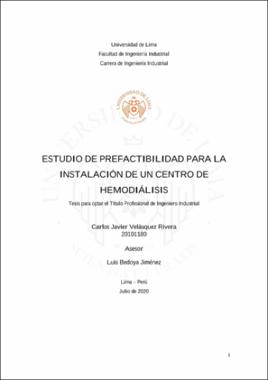Mostrar el registro sencillo del ítem
Estudio de prefactibilidad para la instalación de un centro de hemodiálisis
| dc.contributor.advisor | Bedoya Jiménez, Luis | |
| dc.contributor.author | Velásquez Rivera, Carlos Javier | |
| dc.date.accessioned | 2020-09-22T14:41:26Z | |
| dc.date.available | 2020-09-22T14:41:26Z | |
| dc.date.issued | 2020 | |
| dc.identifier.citation | Velásquez Rivera, C. J. (2020). Estudio de prefactibilidad para la instalación de un centro de hemodiálisis (tesis para optar el título profesional de Ingeniero Industrial). Universidad de Lima. | es_PE |
| dc.identifier.uri | https://hdl.handle.net/20.500.12724/11595 | |
| dc.description.abstract | Currently, kidney failure is a disease that occurs when the kidneys suddenly lose the ability to filter waste from the blood. When this occurs, harmful levels of waste can accumulate and there may be an imbalance in the chemical composition of the blood. There are two types of renal failure: acute and chronic. In the case of chronic renal failure, this leads to a dialysis program to cope with this disease. Given this problem, an alternative is presented for patients with chronic renal failure: the installation of a hemodialysis center. In this way, it is sought to provide the service to patients with social insurance and who need to be dialyzed, this service will be covered by EsSalud in its entirety and the patients will be evaluated and attended by the hemodialysis center assistance staff. Hemodialysis is a medical treatment that artificially removes harmful or toxic substances from the blood using a hemodialysis machine. For this, patients have previously placed a fistula or catheter through which they are connected to the machine. This treatment is performed three times a week in patients in stage 5 (terminal phase) and the duration of each session is three to four hours, depending on the amount of fluid to be extracted to the patient. For all the above, the installation of a hemodialysis center as a treatment for patients with chronic renal failure would help to improve the patient´s quality of life, generate employment, motivate them to investigate kidney failure and chronic diseases, encourage new doctors to specialize in nephrology and the state to encourage the creation of more dialysis centers since about 300 centers are currently needed and only have 140. | en_EN |
| dc.description.abstract | Actualmente, la insuficiencia renal es una enfermedad que ocurre cuando los riñones pierden repentinamente la capacidad de filtrar los desperdicios de la sangre. Cuando ocurre esto, pueden acumularse niveles nocivos de desechos y puede haber un desequilibrio en la composición química de la sangre. Existen dos tipos de insuficiencia renal: aguda y crónica. En el caso de la insuficiencia renal crónica esta conlleva a entrar en programa de diálisis para poder sobrellevar esta enfermedad. Ante esta problemática se presenta una alternativa para los pacientes con insuficiencia renal crónica: la instalación de un centro de hemodiálisis. De esta manera se busca brindar el servicio a los pacientes con seguro social y que necesitan ser dializados, este servicio será cubierto por EsSalud en su totalidad y los pacientes serán evaluados y atendidos por el personal asistencial del centro de hemodiálisis. La hemodiálisis es un tratamiento médico que elimina de manera artificial mediante la ayuda de una máquina de hemodiálisis sustancias nocivas o tóxicas de la sangre, para ello previamente a los pacientes se les ha colocado una fístula o catéter mediante el cual son conectados a la máquina. Este tratamiento se realiza tres veces por semana en pacientes en estadio 5 (fase terminal) y la duración de cada sesión es de tres a cuatros horas, dependiendo de la cantidad de líquido a extraer al paciente. Por todo lo antes expuesto, la instalación de un centro de hemodiálisis como tratamiento para los pacientes con insuficiencia renal crónica ayudaría a mejorar la calidad de vida del paciente, generar empleo, motivar a investigar sobre las insuficiencia renal y enfermedades crónicas, incentivar a nuevos médicos a especializarse en nefrología y al estado en incentivar la creación de más centros de diálisis ya que actualmente se necesitan alrededor de 300 centros y solo se cuentan con 140. | es_PE |
| dc.description.uri | Tesis | |
| dc.format | application/pdf | |
| dc.language.iso | spa | |
| dc.publisher | Universidad de Lima | |
| dc.rights | info:eu-repo/semantics/openAccess | * |
| dc.rights.uri | https://creativecommons.org/licenses/by-nc-sa/4.0/ | * |
| dc.source | Repositorio Institucional - Ulima | |
| dc.source | Universidad de Lima | |
| dc.subject | Prefeasibility studies | en_EN |
| dc.subject | Hemodialysis facilities | en_EN |
| dc.subject | Health services | en_EN |
| dc.subject | Servicios de hemodiálisis | es_PE |
| dc.subject | Servicios de salud | es_PE |
| dc.subject | Estudios de prefactibilidad | es_PE |
| dc.title | Estudio de prefactibilidad para la instalación de un centro de hemodiálisis | es_PE |
| dc.type | info:eu-repo/semantics/bachelorThesis | |
| thesis.degree.level | Título Profesional | |
| thesis.degree.discipline | Ingeniería Industrial | es_PE |
| thesis.degree.grantor | Universidad de Lima. Facultad de Ingeniería y Arquitectura | |
| dc.publisher.country | PE | |
| dc.type.other | Tesis | |
| thesis.degree.name | Ingeniero Industrial | |
| renati.advisor.orcid | https://orcid.org/0000-0003-4718-054X | |
| renati.discipline | 722026 | |
| dc.identifier.isni | 121541816 | |
| renati.author.dni | 47584083 | |
| renati.level | https://purl.org/pe-repo/renati/level#tituloProfesional | * |
| renati.advisor.dni | 06774640 | |
| renati.juror | Goñi Delión, Juan Carlos | |
| renati.juror | Bedoya Jiménez, Luis | |
| renati.juror | Fernández Goicochea, William | |
| renati.juror | Montoya Ramírez, Manuel | |
| renati.type | https://purl.org/pe-repo/renati/type#tesis | * |
| dc.subject.ocde | https://purl.org/pe-repo/ocde/ford#2.11.04 | |
| ulima.cat | OI |
Ficheros en el ítem
Este ítem aparece en la(s) siguiente(s) colección(ones)
-
Tesis [1167]



